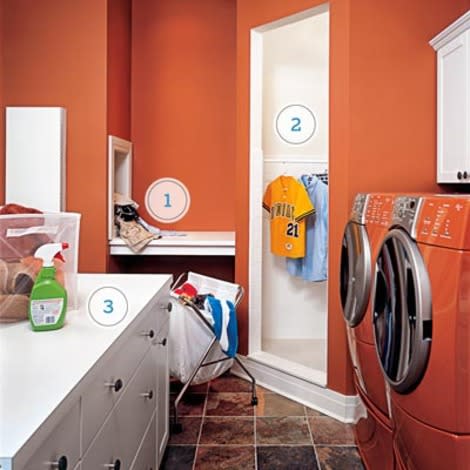8 Tips for Remodeling Your Laundry Room
The laundry room has finally come into its own as a bright and organized cleanup command center, whether in a tidy corner of the basement or a nook next to the kitchen. For help updating yours, check out our expert advice on everything from energy-wise machines and thrifty flooring options to the best labor-saving layout and how to safeguard the house from a potential flood or fire. -Laura Fisher Kaiser
See all our expert advice on renovating you laundry room at ThisOldHouse.com
Where to Put It
For lots of us, the basement is just fine. But many homeowners who can spare the space and expense prefer to have the laundry closer to bedrooms or the kitchen. Here's what to factor in before making a move.
On an upper floor
Pros: Proximity to where dirty clothes are shed lessens schlepping distance with hampers. Can tap into existing plumbing lines if in or near a bathroom.
Cons: Noise and vibration require extra insulation and a motion-arresting pad. Leaks can damage first-floor rooms. Closet installation requires a vented door and additional space around stacked machines to dissipate dryer heat.
See our advice for setting up your laundry room on a lower floor.
The Case for Front Loaders
They cost about $150 to $300 more, but front-loading washers tend to clean better and more efficiently than most top loaders-a faster spin cycle, up to 1,200 rpm, wrings out more water to cut drying time and energy consumption. A front loader also offers design flexibility and comfort; you can stack it with a dryer to save floor space, top it with a counter for folding, or raise it on a pedestal to a back-friendly height. To do the latter with a top-loading washer, you'd have to be part giraffe to reach inside the machine.
Click to learn about add-ons that can be purchased for your front-loading dryer.
Keep It Safe
Washer mishaps are among the leading causes of home floods, and dryers account for thousands of fires annually. But with some key supplies, you can avert disaster and save thousands. Here's what you'll need:
• Braided steel washer hoses, shown left, that can't split open like rubber ones.
• Metal dryer-vent pipe sealed with foil tape, rather than a plastic flex hose, which is a fire hazard.
• A washer box that's recessed in the wall so that water valves are easily accessible and hoses don't loosen or get damaged by getting squished behind the machine.
Oatey Washing Machine Outlet Box, $23; The Home Depot
Click to read more washer and dryer safety tips.
Decoding Energy Star Labels
Most HE (high-efficiency) washers are also rated by MEF and WF. Here's what the new acronyms mean:
MEF: Modified Energy Factor is a measure of the energy used to run the washer and heat the water. The higher the MEF, the more energy-efficient the washer.
WF: Water Factor is based on the number of gallons of water consumed per cubic foot of capacity. The lower the WF, the more miserly the washer.
Click to read about more laundry room-related tips and tricks.
The Best Basket If You...
Take sorting seriously: Individual stacking baskets that nest ($10 each), or a metal frame that holds multiple removable fabric bags ($35).
Like to roll: A wheeled garment rack with bins ($20 to $40).
Navigate stairs: Lightweight, soft-sided vertically shaped bins, similar to the loop-handled canvas one (shown, about $20 each). Traditional rectangular baskets are unwieldy and lead to scraped knuckles.
Click to learn more about getting your laundry room just right.
Smart and Cheery Finish Materials
Chemicals, water, and soiled items tend to get splashed, sprayed, and dumped in a laundry room, so when it comes to finishes, prioritize durability and affordability over luxury. But that doesn't mean your room needs to be dull. Consider these hardworking, thrifty surface options that can also inject color and texture to liven up your laundry space.
Floors: Glue-down linoleum (shown), cork, and vinyl floors shrug off moisture with less upkeep than wood and without the worry of ceramic tiles' cracking or dingy grout lines.
Click to read about more finishes for your laundry room.

All the Extras
There are dozens of ways to upgrade your laundry room, but which of the bells and whistles are really worth the extra money?
Worth the splurge
• Replacing an old washer. Switching out one that's more than 10 years old for an Energy Star model can save you $35 a year in energy bills because they are 30 percent more efficient and use 50 percent less water. Plus, you may qualify for rebates and tax credits. • Stainless-steel washer tubs and dryer drums. They last longer than plastic or porcelain-coated steel and won't chip, crack, scratch, or leave rust stains on clothes.
• Laundry chute (1). If you've got a clear path between floors-no wiring, plumbing, or ductwork to contend with-eliminating those tiring trips down the stairs with arms full of dirties can be easier than you may think. Old-house owners may even be able to convert a decommissioned dumbwaiter.
• Simple shower stall (2). Use it to bathe the dog, rinse off muddy outdoor gear, and hang clothes as they drip-dry.
• Movable or built-in island (3). Not just for kitchens, these workhorses can serve as a folding table or a homework station with stool seating, and provide extra storage for cleaning products, the toolbox, even craft and gift-wrapping supplies.
Click to read about more extras you can use to upgrade your laundry room.
Also on ThisOldHouse.com:
30 Down-and-Dirty Tricks for Big DIY Savings
47 Skills You Need to Survive Homeownership
A Year's Worth of Smart Home Solutions
